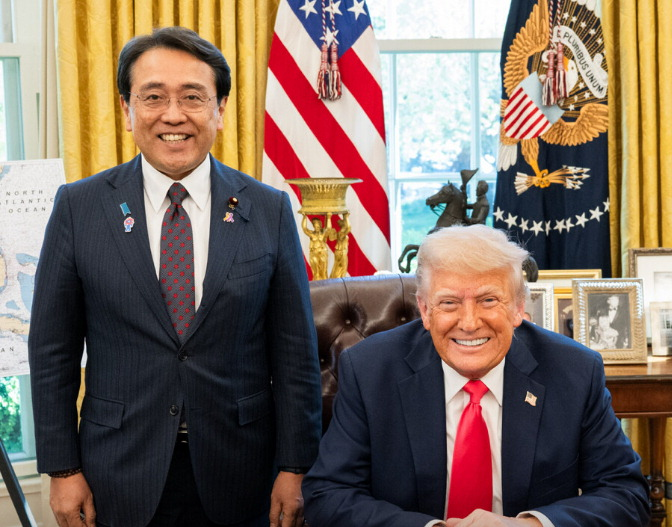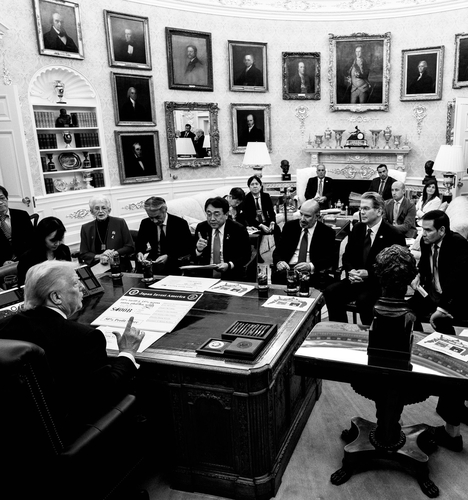Japan Concedes to U.S. Demands, ‘Trump Tariff Deal’ to Be Put in Writing
Input
Modified
U.S. Secures Documentation of Details Interpretive Gap on ‘Tariff Agreement’ Narrowed Agreement Expected to Be Drafted as Early as This Week

The United States and Japan have agreed to draw up a document regarding Japan’s $550 billion investment in the U.S., which was part of their tariff deal. Although Japan concluded negotiations with Washington in July over investment, auto tariffs, and reciprocal tariffs, it had insisted on not drafting a formal agreement. However, President Donald Trump’s strong demand for documentation has forced Tokyo to yield once again.
U.S. and Japan Move to Partially Formalize Tariff Agreement
According to Reuters on the 27th (local time), the two governments will prepare a joint document detailing Japan’s U.S.-bound investment. The document is expected to outline the framework of Japan’s investment and related aspects of reciprocal tariff negotiations, but without legal binding force.
To this end, Ryosei Akazawa, the cabinet minister in charge of the tariff negotiations, is expected to visit the U.S. soon. Speaking to reporters the previous day, Akazawa remarked, “It is the U.S. side that wants a joint document and believes it advantageous,” adding that consultations are underway “to ensure faithful implementation of the (reciprocal tariff) agreement.” From the outset, Tokyo had maintained that it was preferable to preserve “strategic ambiguity” rather than put the agreement into writing. His remarks underscored that it is Washington, not Tokyo, pressing for a formalized text.
The Japanese government had consistently argued there was no need for an agreement, warning that such a document could restrict policy flexibility. But as U.S. media criticized the administration for being outmaneuvered by Tokyo in the negotiations, Washington pressed Japan more forcefully to produce a joint text.

Trump Personally Revises Agreement Terms by Hand During Talks with Japanese Delegation
Last month, the U.S. and Japan agreed to lower reciprocal tariffs (25%) and auto tariffs (27.5%) on Japanese exports to 15%. In exchange, Tokyo pledged $550 billion in U.S.-bound investment along with partial market openings for American rice and automobiles. Reports indicate that President Trump’s personal intervention heavily shaped the final deal.
Analysis of a photograph posted on X on July 24 by White House Deputy Chief of Staff Dan Scavino showed a document on Trump’s desk titled “Japan Invest America.” The figure “$400 billion” had been crossed out, replaced in handwriting with “$500 billion.” Japan had initially proposed $400 billion in investment, but Trump, upon reviewing the report, is believed to have raised the figure to $500 billion on the spot.
On July 23, the day before the photo was released, Trump announced the trade deal on his social media platform Truth Social, stating that Japan would invest $550 billion in the U.S. and that 90% of the profits from the investment would accrue to America. Yet the document in the photo listed the profit-sharing ratio not as 90% but as 50%. Foreign media speculated that Trump himself may have altered that figure as well. Taken together, the announcement and the photo suggest Trump pressured Japan for greater concessions after reviewing the ministerial-level accord.
Following the conclusion of talks, however, Japan clarified that the $550 billion figure did not represent purely cash investment but included loans, guarantees, and equity contributions. Actual equity investment, Tokyo explained, would amount to only 1–2% of the total. Agencies such as the Japan Bank for International Cooperation (JBIC) and Nippon Export and Investment Insurance (NEXI) were expected to provide equity, loans, or guarantees within capped limits. The U.S., however, insisted that “the investment amount is as directed by the U.S. government,” underscoring a wide divergence of views.
Japan Protests Tariff Structure of ‘Existing Rate +15%’ Instead of Flat 15%
On July 7, after reciprocal tariffs took effect, Tokyo lodged a protest upon discovering that tariffs on Japanese goods were being applied as “existing tariffs +15%” rather than a flat 15%. Japan argued it had agreed with Washington that reciprocal tariffs would be capped at 15% in total. Specifically, products with existing tariffs below 15% would face reciprocal tariffs of 15%, while those already above 15% would remain at their previous rates, exempt from additional duties.
However, according to the presidential executive order published in the Federal Register on August 5, such exemptions applied only to the European Union. Other countries, including Japan and South Korea, faced reciprocal tariffs added on top of existing rates. For South Korea, which has an FTA with the U.S. and exports most goods duty-free, the additional 15% would not apply. But Japan, without an FTA, was affected. For example, Japanese apparel previously subject to a 4% tariff would face a total duty of 19%—the original 4% plus the new 15%.
Moreover, Tokyo’s priority issue—auto tariffs—was not reduced. The U.S. has long imposed a 2.5% duty on Japanese automobiles. If the new formula were applied, Japan would face a 17.5% tariff (“2.5% + 15%”). However, automobiles fall under product-specific tariffs rather than reciprocal tariffs, leaving room for potential adjustment in the future.






















Comment